The PCR Plate Sealer Market is estimated to be valued at USD 5.8 billion in 2025 and is projected to reach USD 9.3 billion by 2035, registering a compound annual growth rate (CAGR) of 4.8% over the forecast period.
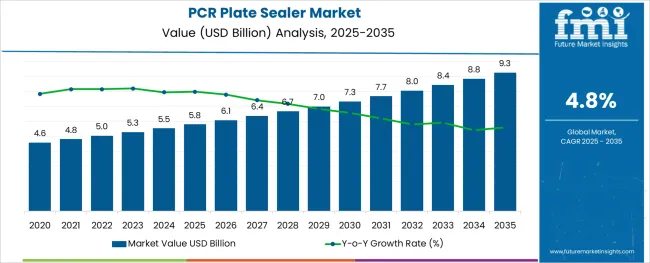
The PCR plate sealer market is experiencing steady growth, driven by increased demand for reliable sample sealing solutions in molecular diagnostics and research laboratories. Advances in testing techniques, particularly for blood and oncology applications, have required precise and contamination-free sealing to ensure test accuracy and reproducibility.
The growing prevalence of cancer and blood disorders has intensified the need for efficient PCR workflows, boosting the adoption of specialized plate sealers. Additionally, hospitals and clinics have expanded their molecular diagnostic capabilities to improve patient outcomes, contributing to increased end-user demand.
Technological enhancements in sealing mechanisms have improved ease of use, throughput, and reliability, making these devices integral to laboratory operations. The market is expected to continue growing due to expanding molecular testing, rising investments in healthcare infrastructure, and a focus on diagnostic accuracy. Segmental growth is anticipated to be led by heat sealing technology, blood and oncology testing applications, and hospital and clinic end-users.
The market is segmented by Product Type, Application, and End User and region. By Product Type, the market is divided into Heat Sealing, Adhesive PCR Plate Seals, Cap Strips, PCR Plate Sealing Mats, and Lids. In terms of Application, the market is classified into for Blood and Oncology Testing, for Forensic Science, for Research & Development, and for Pathogen Testing. Based on End User, the market is segmented into for Hospitals & Clinics, for Ambulatory Surgical Centers, for Diagnostic Centers, and for Clinical Research Organizations. Regionally, the market is classified into North America, Latin America, Western Europe, Eastern Europe, Balkan & Baltic Countries, Russia & Belarus, Central Asia, East Asia, South Asia & Pacific, and the Middle East & Africa.
The Heat Sealing segment is projected to hold 44.8% of the PCR plate sealer market revenue in 2025, maintaining its position as the dominant product type. Heat sealing offers robust and consistent sealing quality, which is critical for preventing sample evaporation and contamination during PCR cycles.
Laboratories have favored heat sealing for its reliability across various plate formats and its compatibility with high-throughput workflows. The ability to automate heat sealing processes has also enhanced efficiency in busy molecular diagnostic labs.
Furthermore, heat sealing provides excellent resistance to temperature fluctuations during PCR amplification, ensuring sample integrity. As molecular diagnostic testing volumes continue to rise, the preference for heat sealing plate sealers is expected to persist.
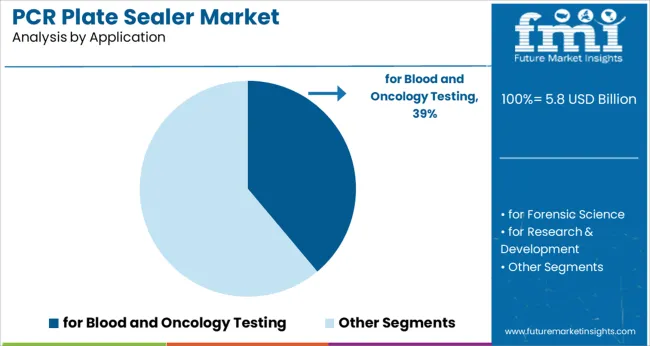
The Blood and Oncology Testing application segment is projected to contribute 38.9% of the market revenue in 2025, establishing itself as the leading application area. The segment's growth is driven by the increased adoption of PCR techniques for detecting genetic mutations, pathogens, and biomarkers associated with blood disorders and cancers.
Accurate sealing of PCR plates is vital to maintaining sample purity and assay sensitivity in these critical applications. Hospitals and research centers conducting blood and oncology tests have expanded molecular diagnostics programs, fueling demand for reliable plate sealing solutions.
As personalized medicine and targeted therapies advance, the importance of precise PCR testing in blood and oncology continues to grow, sustaining this segment’s market dominance.
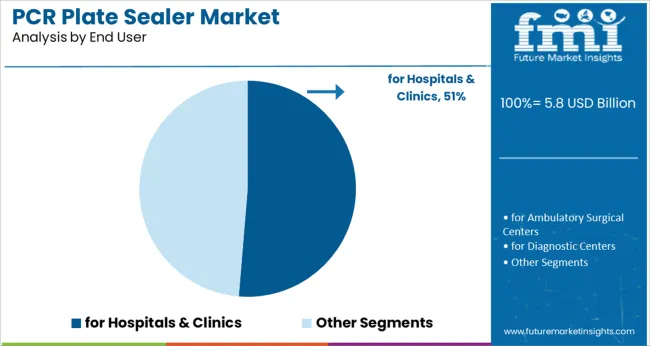
The Hospitals & Clinics end-user segment is projected to account for 51.3% of the PCR plate sealer market revenue in 2025, retaining its leadership position. The growing integration of molecular diagnostics into routine clinical workflows has increased the demand for PCR plate sealers in hospital and clinical laboratory settings.
These environments require dependable sealing technologies to ensure the accuracy and reproducibility of diagnostic tests. Investments in healthcare infrastructure and the expansion of molecular testing services within hospitals and clinics have further boosted this segment.
Additionally, hospitals have emphasized reducing contamination risks and improving test turnaround times, making PCR plate sealers essential tools. The Hospitals & Clinics segment is expected to maintain its strong market presence as molecular diagnostics continue to evolve.
The availability of seals with properties such as peelability, pierceability, optical clarity, temperature stability, and solvent resistance is expected to drive the global plate sealer market. Furthermore, the availability of high-quality sealing instruments, as well as an increase in research activities in the field of life sciences, is expected to boost the market.
Furthermore, advanced features found in automated plate sealer instruments, such as variable temperature and time settings, a touch screen, and a user-friendly interface, is expected to drive the market in the near future. Automation technology and material science advancements are likely to provide appealing opportunities for PCR plate sealer market players to manufacture technologically versatile plate sealer instruments.
The market is expected to be restrained by high maintenance costs and the high cost of advanced plate sealer instruments.

The Asia Pacific market is expected to expand at a rapid pace during the forecast period, as governments undertake initiatives to improve the region's research and development infrastructure. Furthermore, the Asia Pacific region is expected to expand the production of cost-effective yet PCR plate sealer market, with China, in particular, exhibiting rapid growth in the PCR plate sealer market over the forecast period.
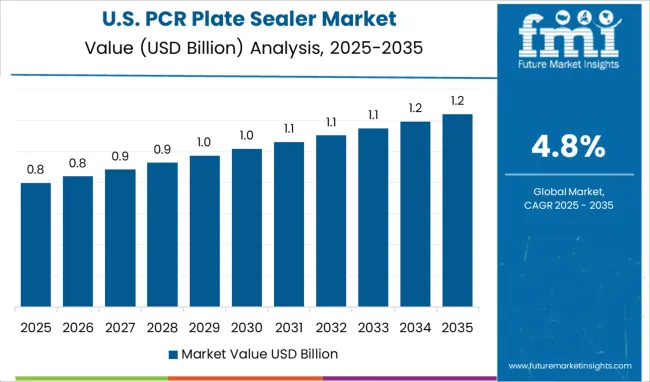
According to Future Market Insights, North America is the most profitable region for the PCR plate sealer market. Because of the presence of a large number of research and development centers and medical device companies, North America contributes to being the highest revenue generating segment. Because of the growing number of diagnostic laboratories and the entry of medical device manufacturing companies in these regions, North America accounts for a sizable revenue share in the PCR plate sealer market.
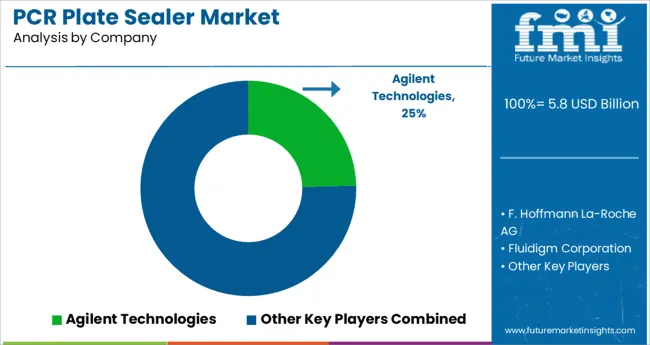
Some of the key participants present in the global PCR Plate Sealer market include Agilent Technologies, F. Hoffmann La-Roche AG, Fluidigm Corporation, QIAGEN, GE Healthcare, Bio Rad Laboratories Inc., Thermo Fischer Scientific, Danaher Corporation and Thomas Scientific among others.
| Report Attribute | Details |
|---|---|
| Growth Rate | CAGR of 4.8% from 2025 to 2035 |
| Base Year for Estimation | 2024 |
| Historical Data | 2020 to 2024 |
| Forecast Period | 2025 to 2035 |
| Quantitative Units | Revenue in billion, Volume in Kilotons and CAGR from 2025 to 2035 |
| Report Coverage | Revenue Forecast, Volume Forecast, Company Ranking, Competitive Landscape, Growth Factors, Trends and Pricing Analysis |
| Segments Covered | Product Type, Application, End User, Region |
| Regions Covered | North America; Latin America; Europe; East Asia; South Asia; Oceania; Middle East & Africa |
| Key Countries Profiled | USA, Canada, Brazil, Mexico, Germany, UK, France, Spain, Italy, Russia, Australia & New Zealand, China, Japan, South Korea, India, ASEAN, GCC, South Africa |
| Key Companies Profiled | Agilent Technologies; F. Hoffmann La-Roche AG; Fluidigm Corporation; QIAGEN; GE Healthcare; Bio Rad Laboratories Inc.; Thermo Fischer Scientific; Danaher Corporation; Thomas Scientific |
| Customization | Available Upon Request |
The global pcr plate sealer market is estimated to be valued at USD 5.8 billion in 2025.
It is projected to reach USD 9.3 billion by 2035.
The market is expected to grow at a 4.8% CAGR between 2025 and 2035.
The key product types are heat sealing, adhesive pcr plate seals, cap strips, pcr plate sealing mats and lids.
for blood and oncology testing segment is expected to dominate with a 38.9% industry share in 2025.






Our Research Products

The "Full Research Suite" delivers actionable market intel, deep dives on markets or technologies, so clients act faster, cut risk, and unlock growth.

The Leaderboard benchmarks and ranks top vendors, classifying them as Established Leaders, Leading Challengers, or Disruptors & Challengers.

Locates where complements amplify value and substitutes erode it, forecasting net impact by horizon

We deliver granular, decision-grade intel: market sizing, 5-year forecasts, pricing, adoption, usage, revenue, and operational KPIs—plus competitor tracking, regulation, and value chains—across 60 countries broadly.

Spot the shifts before they hit your P&L. We track inflection points, adoption curves, pricing moves, and ecosystem plays to show where demand is heading, why it is changing, and what to do next across high-growth markets and disruptive tech

Real-time reads of user behavior. We track shifting priorities, perceptions of today’s and next-gen services, and provider experience, then pace how fast tech moves from trial to adoption, blending buyer, consumer, and channel inputs with social signals (#WhySwitch, #UX).

Partner with our analyst team to build a custom report designed around your business priorities. From analysing market trends to assessing competitors or crafting bespoke datasets, we tailor insights to your needs.
Supplier Intelligence
Discovery & Profiling
Capacity & Footprint
Performance & Risk
Compliance & Governance
Commercial Readiness
Who Supplies Whom
Scorecards & Shortlists
Playbooks & Docs
Category Intelligence
Definition & Scope
Demand & Use Cases
Cost Drivers
Market Structure
Supply Chain Map
Trade & Policy
Operating Norms
Deliverables
Buyer Intelligence
Account Basics
Spend & Scope
Procurement Model
Vendor Requirements
Terms & Policies
Entry Strategy
Pain Points & Triggers
Outputs
Pricing Analysis
Benchmarks
Trends
Should-Cost
Indexation
Landed Cost
Commercial Terms
Deliverables
Brand Analysis
Positioning & Value Prop
Share & Presence
Customer Evidence
Go-to-Market
Digital & Reputation
Compliance & Trust
KPIs & Gaps
Outputs
Full Research Suite comprises of:
Market outlook & trends analysis
Interviews & case studies
Strategic recommendations
Vendor profiles & capabilities analysis
5-year forecasts
8 regions and 60+ country-level data splits
Market segment data splits
12 months of continuous data updates
DELIVERED AS:
PDF EXCEL ONLINE
Plate Chain Elevator Market Size and Share Forecast Outlook 2025 to 2035
Platelet Shaker Market Size and Share Forecast Outlook 2025 to 2035
PCR Tire Building Machine Market Size and Share Forecast Outlook 2025 to 2035
Plate and Frame Heat Exchanger Market Size and Share Forecast Outlook 2025 to 2035
PCR Plastic Packaging Market Size and Share Forecast Outlook 2025 to 2035
Platelet Concentration Systems Market Size and Share Forecast Outlook 2025 to 2035
Platelet Rich Plasma Market Analysis - Size, Share, and Forecast Outlook 2025 to 2035
Plate Electrostatic Precipitator Market Size and Share Forecast Outlook 2025 to 2035
Platelet Function Test Market Report - Growth & Forecast 2025 to 2035
Plate Heat Exchanger Market Growth - Trends & Forecast 2025 to 2035
Breaking Down PCR Films Market Share & Industry Positioning
PCR Films Market Analysis by PET, PS, PVC Through 2035
PCR Bottles Market Growth - Demand, Innovations & Outlook 2024 to 2034
PCR Pouches Market
Plates Market
qPCR Instruments Market Analysis - Growth, Trends & Forecast 2025 to 2035
Tinplate Packaging Market Size and Share Forecast Outlook 2025 to 2035
RF Sealer System Market Size and Share Forecast Outlook 2025 to 2035
Hotplate Stirrers Market Size and Share Forecast Outlook 2025 to 2035
RT-PCR Kits Market Growth - Trends & Forecast 2023 to 2035

Thank you!
You will receive an email from our Business Development Manager. Please be sure to check your SPAM/JUNK folder too.
Chat With
MaRIA